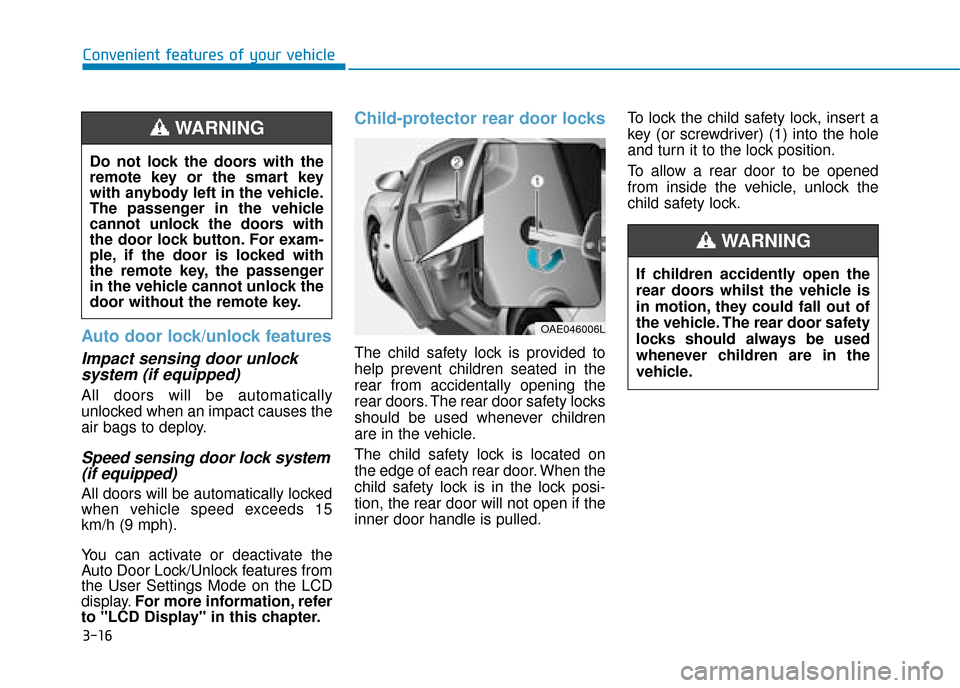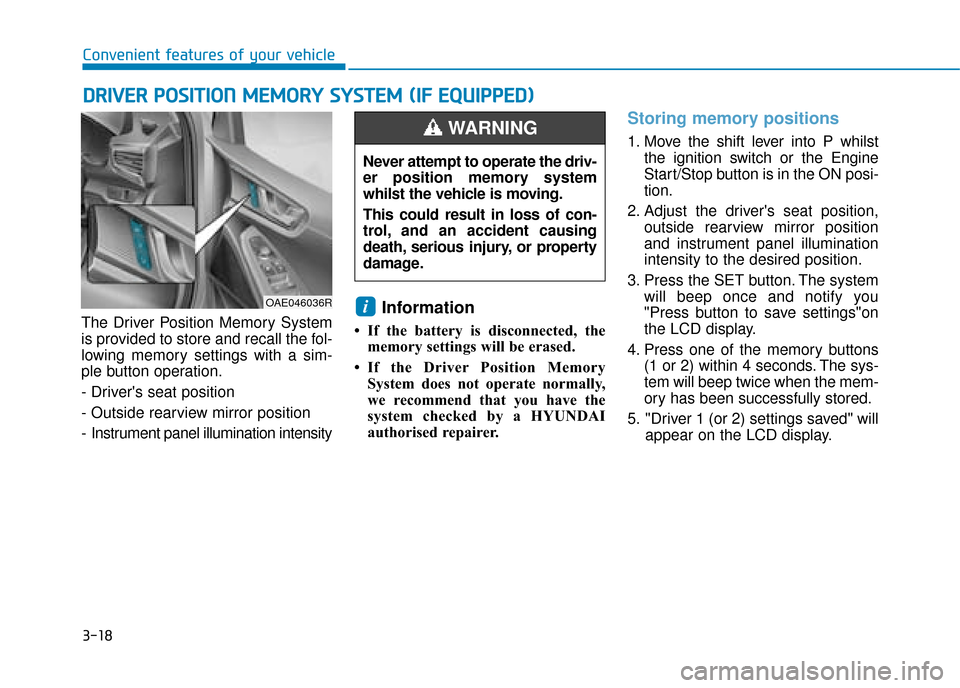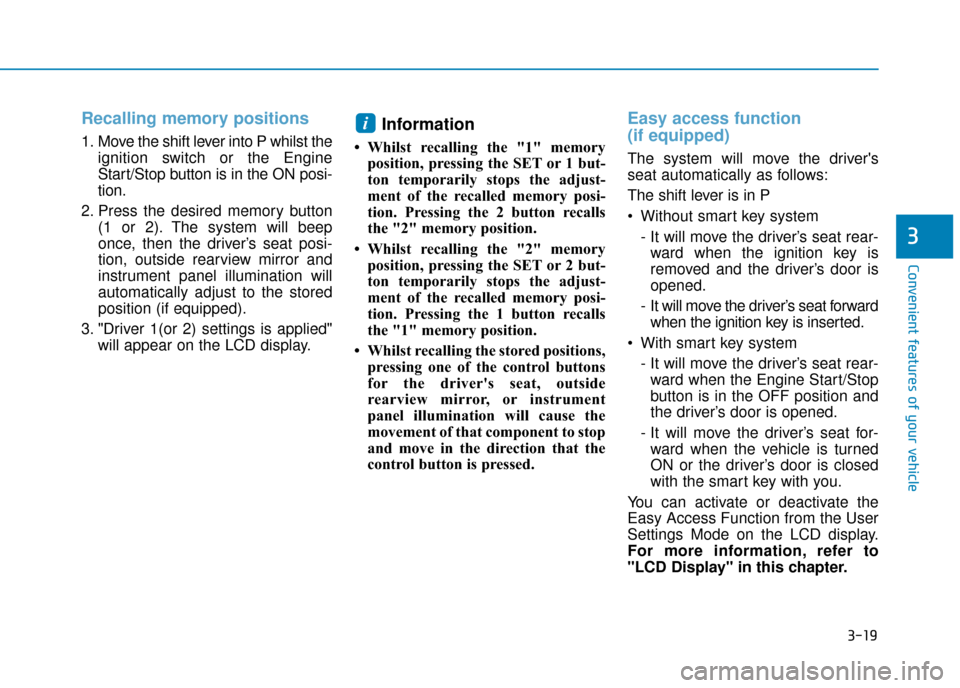2019 Hyundai Ioniq Plug-in Hybrid display
[x] Cancel search: displayPage 44 of 599

H44
Switching to Hybrid mode tolubricate engine (Plug-in hybrid vehicle)
This message is displayed when the
vehicle is automatically switched to
the HEV mode to lubricate engine
whilst the ignition switch is in the ON
position.
Maintaining Hybrid mode to pro-tect engine (Plug-in hybrid vehicle)
This message is displayed when the
[EV/HEV] button is pressed but it is
impossible to switch from the HEV
mode to EV mode due to engine
lubrication.
Exit SPORT to switch to electricmode (Plug-in hybrid vehicle)
This message is displayed when
[EV/HEV] button is pressed but it is
impossible to switch from the HEV
mode to EV mode because the
SPORT mode is engaged.OAEPH047530LOAEPH047528L
OAEPH047531L
D
D R
RI
IV
V I
IN
N G
G
T
T H
H E
E
H
H Y
Y B
BR
RI
ID
D /
/P
P L
LU
U G
G-
-I
IN
N
H
H Y
Y B
BR
RI
ID
D
V
V E
EH
H I
IC
C L
LE
E
(
( C
C O
O N
NT
T.
.)
)
Page 134 of 599

2-57
Safety system of your vehicle
2
SRS warning light
The SRS (Supplement Restraint
System) air bag warning light on the
instrument panel displays the air bag
symbol depicted in the illustration. The
system checks the air bag electrical
system for malfunctions. The light indi-
cates that there is a potential problem
with your air bag system.During a moderate to severe frontal
collision, sensors will detect the vehi-
cle’s rapid deceleration. If the rate of
deceleration is high enough, the con-
trol unit will inflate the front air bags,
at the time and with the force needed.
The front air bags help protect the driv-
er and front passenger by responding
to frontal impacts in which seat belts
alone cannot provide adequate
restraint. When needed, the side air
bags help provide protection in the
event of a side impact or rollover by
supporting the side upper body area.
Air bags are activated (able to
inflate if necessary) only when the
ignition switch is in the ON position.
Air bags inflate in the event of cer-
tain frontal or side collisions to help
protect the occupants from serious
physical injury.
There is no single speed at which the air bags will inflate. Generally,
air bags are designed to inflate
based upon the severity of a colli-
sion and its direction. These two
factors determine whether the sen-
sors produce an electronic deploy-
ment/inflation signal.
If your SRS malfunctions, the
air bag may not inflate properly
during an accident increasing
the risk of serious injury or
death.
If any of the following condi-
tions occur, your SRS is mal-
functioning:
The light does not turn on for
approximately six seconds
when the ignition switch is in
the ON position.
The light stays on after illumi-
nating for approximately six
seconds.
The light comes on whilst the
vehicle is in motion.
The light blinks when the
engine is running.
We recommend that a HYUNDAI
authorised repairer inspect the
SRS as soon as possible if any
of these conditions occur.
WARNING
Page 147 of 599

Convenient features of your vehicle
Accessing your vehicle .........................................3-4
Remote key ........................................................................\
.3-4
Smart key ........................................................................\
....3-7
Immobiliser system .........................................................3-11
Door locks .............................................................3-12
Operating door locks from outside the vehicle ......3-12
Operating door locks from inside the vehicle .........3-14
Deadlocks ........................................................................\
..3-15
Auto door lock/unlock features..................................3-16
Child-protector rear door locks ..................................3-16
Theft-alarm system.............................................3-17
Driver position memory system .........................3-18
Storing memory positions .............................................3-18
Recalling memory positions..........................................3-19
Easy access function .....................................................3-19
Steering wheel......................................................3-20
Electric power steering (EPS) ......................................3-20
Tilt steering / Telescopic steering ..............................3-21
Heated steering wheel ...................................................3-21
Horn ........................................................................\
............3-22
Mirrors ...................................................................3-22
Inside rearview mirror....................................................3-22
Outside rearview mirror ................................................3-24
Windows ................................................................3-27
Power windows................................................................3-27
Sunroof..................................................................3-31
Sunroof opening and closing .......................................3-32
Sliding the sunroof .........................................................3-32
Tilting the sunroof ..........................................................3-33
Sunshade ........................................................................\
...3-34
Resetting the sunroof ....................................................3-34
Exterior features .................................................3-35
Bonnet........................................................................\
........3-35
Tailgate.....................................................................\
..........3-37
Fuel filler door (Hybrid vehicle) ..................................3-38
Fuel filler door (Plug-in hybrid vehicle) ...................3-41
Instrument cluster................................................3-44
Instrument cluster control ............................................3-46
Gauges and meters .........................................................3-47
Warning and indicator lights ........................................3-53
LCD display messages ....................................................3-65
3
Page 148 of 599

LCD display ...........................................................3-80
LCD display control.........................................................3-80
LCD display modes (for cluster type A) ....................3-81
LCD display modes (for cluster type B) ....................3-90
Trip computer (hybrid vehicle) ..........................3-97
Trip computer (plug-in hybrid vehicle) ..........3-102
Light .....................................................................3-1\
08
Exterior lights ................................................................3-108
Welcome system ...........................................................3-113
Interior lights..................................................................3-115
Wipers and washers ..........................................3-118
Windscreen wipers .......................................................3-118
Windscreen washers ....................................................3-120
Driver Assist System .........................................3-121
Rear view monitor ........................................................3-121
Parking distance warning (Reverse) system ..........3-122
Parking distance warning (Reverse/Forward)
system........................................................................\
......3-124
Automatic climate control system ...................3-128
Automatic heating and air conditioning ..................3-129
Manual heating and air conditioning .......................3-130
System operation ..........................................................3-137
System maintenance ....................................................3-139
Windscreen defrosting and defogging ...........3-142
Automatic climate control system ............................3-142
Defogging logic..............................................................3-143
Auto defogging system ...............................................3-144
Defroster ........................................................................\
.3-145
Climate control additional features.................3-146
Automatic ventilation ...................................................3-146
Sunroof inside air recirculation.................................3-146
Storage compartment ........................................3-147
Centre console storage ...............................................3-147
Glove box ........................................................................\
3-147
Sunglass holder .............................................................3-148
Multi box ........................................................................\
.3-148
3
Page 162 of 599

3-16
Convenient features of your vehicle
Auto door lock/unlock features
Impact sensing door unlocksystem (if equipped)
All doors will be automatically
unlocked when an impact causes the
air bags to deploy.
Speed sensing door lock system
(if equipped)
All doors will be automatically locked
when vehicle speed exceeds 15
km/h (9 mph).
You can activate or deactivate the
Auto Door Lock/Unlock features from
the User Settings Mode on the LCD
display. For more information, refer
to "LCD Display" in this chapter.
Child-protector rear door locks
The child safety lock is provided to
help prevent children seated in the
rear from accidentally opening the
rear doors. The rear door safety locks
should be used whenever children
are in the vehicle.
The child safety lock is located on
the edge of each rear door. When the
child safety lock is in the lock posi-
tion, the rear door will not open if the
inner door handle is pulled. To lock the child safety lock, insert a
key (or screwdriver) (1) into the hole
and turn it to the lock position.
To allow a rear door to be opened
from inside the vehicle, unlock the
child safety lock.
OAE046006L
If children accidently open the
rear doors whilst the vehicle is
in motion, they could fall out of
the vehicle. The rear door safety
locks should always be used
whenever children are in the
vehicle.
WARNING
Do not lock the doors with the
remote key or the smart key
with anybody left in the vehicle.
The passenger in the vehicle
cannot unlock the doors with
the door lock button. For exam-
ple, if the door is locked with
the remote key, the passenger
in the vehicle cannot unlock the
door without the remote key.
WARNING
Page 164 of 599

3-18
Convenient features of your vehicle
The Driver Position Memory System
is provided to store and recall the fol-
lowing memory settings with a sim-
ple button operation.
- Driver's seat position
- Outside rearview mirror position
- Instrument panel illumination intensity
Information
• If the battery is disconnected, the memory settings will be erased.
• If the Driver Position Memory System does not operate normally,
we recommend that you have the
system checked by a HYUNDAI
authorised repairer.
Storing memory positions
1. Move the shift lever into P whilst the ignition switch or the Engine
Start/Stop button is in the ON posi-
tion.
2. Adjust the driver's seat position, outside rearview mirror position
and instrument panel illumination
intensity to the desired position.
3. Press the SET button. The system will beep once and notify you
"Press button to save settings"on
the LCD display.
4. Press one of the memory buttons (1 or 2) within 4 seconds. The sys-
tem will beep twice when the mem-
ory has been successfully stored.
5. "Driver 1 (or 2) settings saved" will appear on the LCD display.
i
D DR
RI
IV
V E
ER
R
P
P O
O S
SI
IT
T I
IO
O N
N
M
M E
EM
M O
OR
RY
Y
S
S Y
Y S
ST
T E
EM
M
(
( I
IF
F
E
E Q
Q U
UI
IP
P P
PE
ED
D )
)
OAE046036R
Never attempt to operate the driv-
er position memory system
whilst the vehicle is moving.
This could result in loss of con-
trol, and an accident causing
death, serious injury, or property
damage.
WARNING
Page 165 of 599

3-19
Convenient features of your vehicle
3
Recalling memory positions
1. Move the shift lever into P whilst theignition switch or the Engine
Start/Stop button is in the ON posi-
tion.
2. Press the desired memory button (1 or 2). The system will beep
once, then the driver’s seat posi-
tion, outside rearview mirror and
instrument panel illumination will
automatically adjust to the stored
position (if equipped).
3. "Driver 1(or 2) settings is applied" will appear on the LCD display.
Information
• Whilst recalling the "1" memoryposition, pressing the SET or 1 but-
ton temporarily stops the adjust-
ment of the recalled memory posi-
tion. Pressing the 2 button recalls
the "2" memory position.
• Whilst recalling the "2" memory position, pressing the SET or 2 but-
ton temporarily stops the adjust-
ment of the recalled memory posi-
tion. Pressing the 1 button recalls
the "1" memory position.
• Whilst recalling the stored positions, pressing one of the control buttons
for the driver's seat, outside
rearview mirror, or instrument
panel illumination will cause the
movement of that component to stop
and move in the direction that the
control button is pressed.
Easy access function
(if equipped)
The system will move the driver's
seat automatically as follows:
The shift lever is in P
Without smart key system
- It will move the driver’s seat rear-ward when the ignition key is
removed and the driver’s door is
opened.
- It will move the driver’s seat forward when the ignition key is inserted.
With smart key system - It will move the driver’s seat rear-ward when the Engine Start/Stop
button is in the OFF position and
the driver’s door is opened.
- It will move the driver’s seat for- ward when the vehicle is turned
ON or the driver’s door is closed
with the smart key with you.
You can activate or deactivate the
Easy Access Function from the User
Settings Mode on the LCD display.
For more information, refer to
"LCD Display" in this chapter.
i
Page 187 of 599

3-41
Convenient features of your vehicle
Fuel filler door
(Plug-in hybrid vehicle)
Opening the fuel filler door
1. Turn the vehicle off.
2. Push the fuel filler door openerbutton. 3. Wait until the fuel tank is depres-
surized.
The message ''Fuel door open'' is displayed when the fuel filler door
opens after the fuel tank is
depressurized.
Information
• It may take up to 20 seconds to open the fuel filler door.
• When the fuel filler door is frozen and does not open after 20 seconds
at freezing temperature, slightly tap
the fuel filler door and then attempt
to open it. 4. Pull the fuel filler door (1) out to
fully open.
5. To remove the fuel tank cap (2), turn it anticlockwise. You may hear
a hissing noise as the pressure
inside the tank equalizes.
6. Place the cap on the fuel filler door.
i
3
OAEPH047024R
OAEPH047025LOLFP045236N/OAEPH047525L